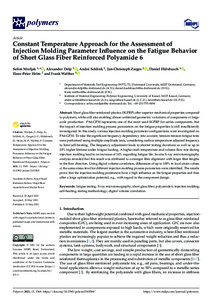Constant Temperature Approach for the Assessment of Injection Molding Parameter Influence on the Fatigue Behavior of Short Glass Fiber Reinforced Polyamide 6
| dc.date.accessioned | 2023-06-16T11:55:26Z | |
| dc.date.available | 2023-06-16T11:55:26Z | |
| dc.date.issued | 2021-05-13 | |
| dc.identifier | doi:10.17170/kobra-202306168251 | |
| dc.identifier.uri | http://hdl.handle.net/123456789/14836 | |
| dc.language.iso | eng | |
| dc.rights | Namensnennung 4.0 International | * |
| dc.rights.uri | http://creativecommons.org/licenses/by/4.0/ | * |
| dc.subject | fatigue testing | eng |
| dc.subject | X-ray microtomography | eng |
| dc.subject | short glass fiber | eng |
| dc.subject | polyamide 6 | eng |
| dc.subject | injection molding | eng |
| dc.subject | self-heating | eng |
| dc.subject | testing methodology | eng |
| dc.subject | digital volume correlation | eng |
| dc.subject.ddc | 600 | |
| dc.title | Constant Temperature Approach for the Assessment of Injection Molding Parameter Influence on the Fatigue Behavior of Short Glass Fiber Reinforced Polyamide 6 | eng |
| dc.type | Aufsatz | |
| dcterms.abstract | Short glass fiber reinforced plastics (SGFRP) offer superior mechanical properties compared to polymers, while still also enabling almost unlimited geometric variations of components at large-scale production. PA6-GF30 represents one of the most used SGFRP for series components, but the impact of injection molding process parameters on the fatigue properties is still insufficiently investigated. In this study, various injection molding parameter configurations were investigated on PA6-GF30. To take the significant frequency dependency into account, tension–tension fatigue tests were performed using multiple amplitude tests, considering surface temperature-adjusted frequency to limit self-heating. The frequency adjustment leads to shorter testing durations as well as up to 20% higher lifetime under fatigue loading. A higher melt temperature and volume flow rate during injection molding lead to an increase of 16% regarding fatigue life. In situ X-ray microtomography analysis revealed that this result was attributed to a stronger fiber alignment with larger fiber lengths in the flow direction. Using digital volume correlation, differences of up to 100% in local strain values at the same stress level for different injection molding process parameters were identified. The results prove that the injection molding parameters have a high influence on the fatigue properties and thus offer a large optimization potential, e.g., with regard to the component design. | eng |
| dcterms.accessRights | open access | |
| dcterms.creator | Mrzljak, Selim | |
| dcterms.creator | Delp, Alexander | |
| dcterms.creator | Schlink, André | |
| dcterms.creator | Zarges, Jan-Christoph | |
| dcterms.creator | Hülsbusch, Daniel | |
| dcterms.creator | Heim, Hans-Peter | |
| dcterms.creator | Walther, Frank | |
| dc.relation.doi | doi:10.3390/polym13101569 | |
| dc.subject.swd | Spritzgießen | ger |
| dc.subject.swd | Glasfaser | ger |
| dc.subject.swd | Polyamid 6 | ger |
| dc.subject.swd | Vehalten | ger |
| dc.subject.swd | Materialermüdung | ger |
| dc.subject.swd | Temperatur | ger |
| dc.subject.swd | Tomografie | ger |
| dc.type.version | publishedVersion | |
| dcterms.source.identifier | eissn:2073-4360 | |
| dcterms.source.issue | Issue 10 | |
| dcterms.source.journal | Polymers | eng |
| dcterms.source.volume | Volume 13 | |
| kup.iskup | false | |
| dcterms.source.articlenumber | 1569 |
Dateien zu dieser Ressource
Das Dokument erscheint in:
-
Publikationen [75]


